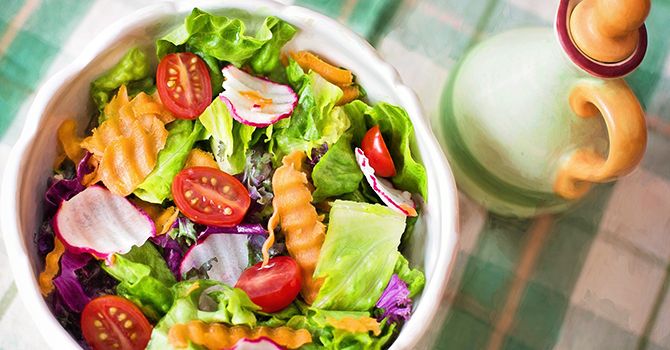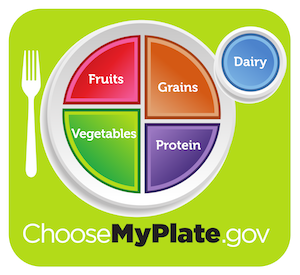Perceived Barriers to Going Vegetarian—and What You Can Do About Them

Nikki Flynn
If you are considering a plant-based or vegetarian diet, you might be concerned about the added costs this lifestyle could present or your ability to get enough protein. However, as I learned this summer from a dedicated vegetarian food pantry customer, it is very possible to live a healthy, protein-rich vegetarian lifestyle on a tight budget.
A vegetarian diet typically involves avoiding meat, fish, and poultry. People often choose a vegetarian diet for a variety of reasons--ethical, environmental, religious, and health reasons are among the most common (Academy of Nutrition and Dietetics, 2016).
A vegetarian diet can be very protective of health. As you eat more fruits, vegetables, and fiber on a vegetarian diet, you typically eat less saturated fat, which leads to improved cholesterol, lower blood pressure, better long-term heart health, and improved quality of life (Academy of Nutrition and Dietetics, 2016).
 Tips for a balanced vegetarian diet on a budget:
Tips for a balanced vegetarian diet on a budget:
- Use dried rice and beans, as they are generally cheaper than boxed or canned
- Utilize the ChooseMyPlate technique when planning meals
- Shop for fresh produce when in season, which is typically less expensive
- When not in season, use canned or frozen produce--the nutrient quality in canned or frozen produce is the same or better as fresh produce because it is packed and processed at peak season
- Avoid health food stores, as the products tend to be more expensive
- Try new foods like legumes or lentils
- Buy dry goods (beans, rice, whole grain pasta, etc.) in bulk
- Avoid vegetarian processed foods (soups, cookies, baked treats, etc.)--in addition to being expensive, they tend to contain more sodium and fat than homemade foods.
Without meat, poultry, and fish in their diets, many vegetarians eat foods like legumes and grains to get enough protein throughout the day. When eating a balanced plant diet throughout the day, most individuals are able to achieve the suggested protein amount.
Low-cost vegetarian sources of proteins:
- Eggs
- Low-fat milk and yogurt
- Tofu
- Lentils
- Chickpeas
- Black, kidney, pinto, and red beans
- Nuts, seeds, and legumes
- Peanut butter
This recipe is a great way to make a healthy, high-protein vegetarian meal on a budget. Talk to your doctor or dietician before making any significant changes to your diet.
Black Bean and Rice Freezer Burritos
300-360 calories per burrito
These burritos are a nutritious, inexpensive, and delicious vegetarian option! Each burrito contains 14g of protein (1/3 of daily target).
Ingredients:
- 8 flour tortillas
- 1 cup cooked brown rice
- 1 cup cooked black beans
- 1 can corn
- 1 medium onion, diced
- 1 medium green pepper, diced
- 1 packet taco seasoning
- Extras: 1 cup shredded cheese of choice, 1/2 cup medium salsa, 1 tsp plain yogurt or sour cream
Directions:
- Prepare brown rice and black beans as noted on the packaging
- In a large mixing bowl, combine brown rice, black beans, corn, onion, green pepper, taco seasoning, and any extras
- Wrap the tortillas in a damp paper towel and microwave for 25 seconds
- Add 1/4 cup of the burrito mixture to center of warm tortilla, fold the ends together, and wrap with Saran wrap
- Place wrapped burritos in a gallon sized freezer bag
- To reheat: place frozen burrito in microwave for 1:30. Remove Saran wrap and microwave for an additional 1:30.
Resources
- EatRight.org
- ChooseMyPlate website for more suggestions on a balanced diet
- USDA.org for SNAP information
- Supplemental Nutrition Assistance Program
- Nationally funded for those of low-income
- Local food pantry information
References
Melina, V., Craig, W., Levin, S. (2016). Position of the Academy of Nutrition and Dietetics: Vegetarian Diets. Journal of the Academy of Nutrition and Dietetics, 116(12), 1970-1980.
About the Author
 Nikki Flynn is currently in her second year at the University of Michigan School of
Public Health with the goal of becoming a registered dietician. Once graduated and
certified, she hopes to do nonprofit work in a community-based setting. Specifically,
Flynn is interested in food education for those living in rural, low-income areas
in Michigan.
Nikki Flynn is currently in her second year at the University of Michigan School of
Public Health with the goal of becoming a registered dietician. Once graduated and
certified, she hopes to do nonprofit work in a community-based setting. Specifically,
Flynn is interested in food education for those living in rural, low-income areas
in Michigan.
